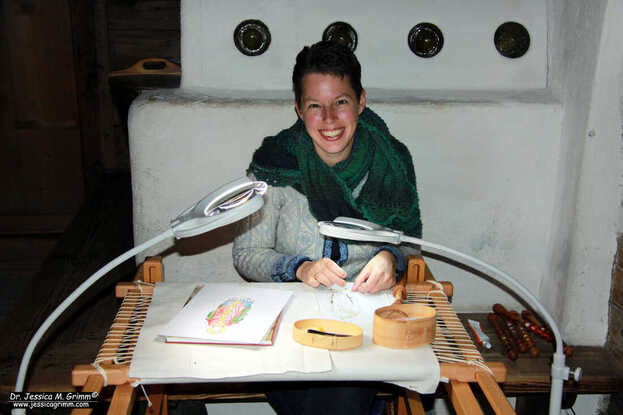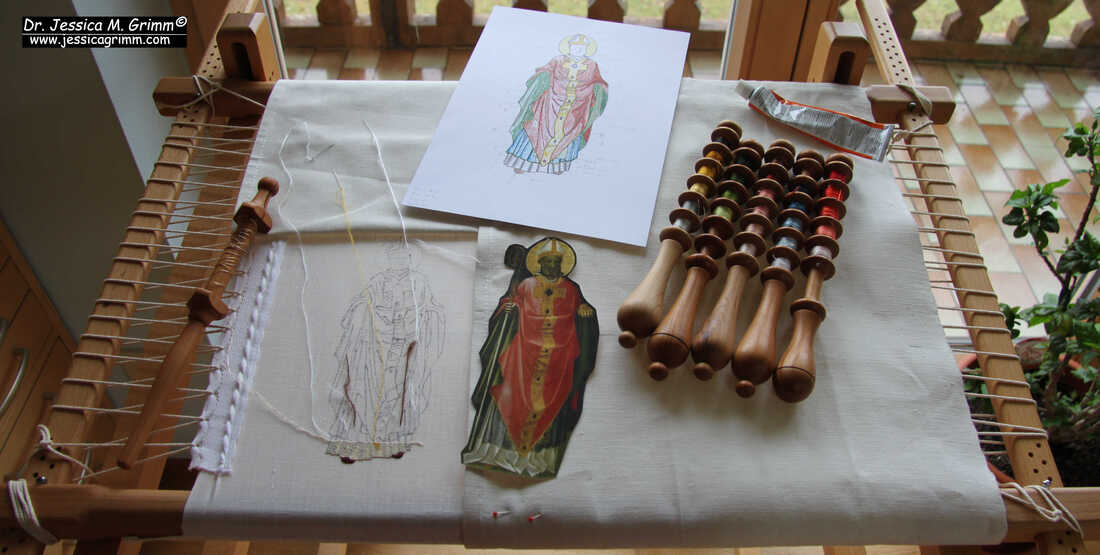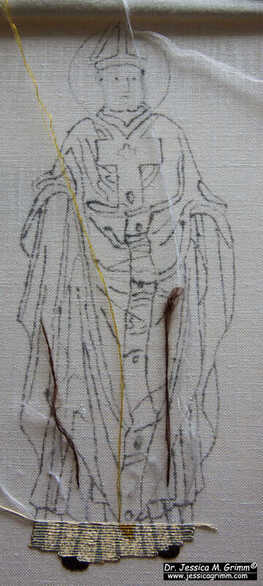|
The past weekend, I have been demonstrating goldwork embroidery at the Open Air Museum Glentleiten near my home. Although Covid numbers are sharply rising and the weather was rather drab and wet, quite a few visitors knocked on the door of building 11 to learn all about late medieval or nue. My abode for the weekend was a farmhouse from Sauerlach near Munich built in AD 1637/38. It had a fantastic built-in oven. With ceramic beakers in the oven wall. The air warms quickly in these ceramic pockets and then expands into the room. This meant that I had a constant hot airflow over my neck and shoulders as I was working. I herewith propose a UN stichers charter in which embroiderers have a right to such ovens in their dwellings :). I started a "new" old project for my demonstration of the or nue technique: St Nick. THE St Nick from "On the shores of St Nick" a piece I have been working on, on and off, for a couple of years now. As I wanted to copy the likely method used in the late-medieval period for working or nue saints, I started by finding a suitable painting. I choose one by Gherardo Starnina painted around AD 1422. Then I turned this painting into a simplified stitch plan. It is believed that medieval stitchers worked from existing models too. After all, plenty of inspiration was on display in every church. For the next step, I made a pricking of my stitch plan and used some black pounce to get it onto my Sotema 48 ct 100% linen. I then connected my dots with iron gall ink. By working slowly and with very little ink on my tiny brush, I was sometimes able to achieve the same thin lines you see on medieval embroidery pieces. One thing that certainly helps to make very thin lines is using as little pounce as you can get away with. Heavy black dots seem to make the ink bleed more. The rest is: practice, practice and then practice some more. The advantage of using ink over paint: when done well, you can make much thinner lines. This is especially useful when transferring an intricate design drawing. Then came the fun part: choosing colours! I use Chinese flat silk for most of my projects. It is high-quality and I can split the thread easily in as many fractions as I like. This means that I have total control over thread thickness. A similar thread was used in medieval embroidery. Alice from Oriental Cultures is always very helpful and dispatches my orders super-fast. I recommend buying a real-thread colour chart as there are nearly 1000 shades of silk available. The goldthread I am using is Stech gilt 80/90 made by Maurer.
As I was talking to visitors most of the time, I haven't made a lot of progress :). And things aren't as neat as they are when I work concentrated. But that's okay! I find it much more important to convey knowledge about an almost forgotten embroidery technique to people who, at best, are familiar with tent stitch and cross-stitch. With a bit of luck, I will become a regular at the museum next year!
6 Comments
Claire de Pourtalès
15/11/2021 15:31:56
Oh my Gosh Jessica! This Saint Nick will be amazing!!! So many ink lines too, I'm so impressed.
Reply
15/11/2021 15:41:31
Thank you, Claire! Yes, I had heard of your St Nick before. Strange story. And poor Dorothea. Amazingly, their 15th-century house is still standing!
Reply
Helen Sewell Johnson
15/11/2021 17:30:05
I love every one of your newsletters! I'd like to know more about the bobbin holders in one of the pictures.
Reply
15/11/2021 17:40:40
Thank you, Helen! The spools with the silk on them were made for me by my local woodworker. I use to sell them in my shop, but they were not popular, so I never had more made.
Reply
15/11/2021 17:51:19
LOL, I started by sitting in between two small windows. But that's not a good idea in November in a 17th-century farmhouse as you can basically peek between the planks and see the neighbour's house ... But sitting on the oven bench was heaven!
Reply
Your comment will be posted after it is approved.
Leave a Reply. |
Want to keep up with my embroidery adventures? Sign up for my weekly Newsletter to get notified of new blogs, courses and workshops!
Liked my blog? Please consider making a donation or becoming a Patron so that I can keep up the good work and my blog ad-free!
Categories
All
Archives
July 2024
|
Contact: info(at)jessicagrimm.com
Copyright Dr Jessica M. Grimm - Mandlweg 3, 82488 Ettal, Deutschland - +49(0)8822 2782219 (Monday, Tuesday, Friday & Saturday 9.00-17.00 CET)
Impressum - Legal Notice - Datenschutzerklärung - Privacy Policy - Webshop ABG - Widerrufsrecht - Disclaimer
Copyright Dr Jessica M. Grimm - Mandlweg 3, 82488 Ettal, Deutschland - +49(0)8822 2782219 (Monday, Tuesday, Friday & Saturday 9.00-17.00 CET)
Impressum - Legal Notice - Datenschutzerklärung - Privacy Policy - Webshop ABG - Widerrufsrecht - Disclaimer









 RSS Feed
RSS Feed